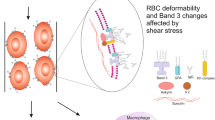Summary
In 21 patients suffering from immunohemolytic anemia of the warm type immunoglobulin types and complement fixation of incomplete warm autoantibodies were determined. 16 patients were controlled over a longer period of time or the entire course of the disease. The following criteria were required to assume the existence of autoantibodies of certain immunochemical type: titer of ≧1∶4 for IgG and IgA resp. ≧1 ∶ 8 for IgM in the direct antiglobulintest, repeated demonstration of a certain immunoglobulin type in the course of the disease, identical results with corresponding antisera of various sources, demonstration of IgG fragments for autoantibodies of the IgG type and detection of the same immunoglobulin class in eluates and on red cells. Results can be summarized as follows:
-
1.
Autoantibodies of IgG type could be detected in all patients. In 9 cases IgG autoantibodies were combined with those of IgA and/or IgM types. Isolated IgA or IgM autoantibodies as well as those of IgD or IgE type could not be detected.
-
2.
Both light chain types were demonstrable in 14 patients. In the remaining cases only kappa chains were found.
-
3.
Complement fixation to red cells was demonstrable in 10 patients at any time of observation.
-
4.
Autoantibodies in chronic-irreversible type of disease showed more immunochemical heterogeneity than in acute-reversible forms. There was no difference between chronic idiopathic and symptomatic disease types.
-
5.
During the course of the disease immunoglobulin classes and complement fixation of detectable autoantibodies varied considerably.
From the observed serological heterogeneity it is concluded that monoclonal origin of autoantibodies is unlikely. A classification of immunohemolytic anemias based solely on immunochemical criteria has little serological and clinical relevance because of the variability of autoantibodies during the course of the disease.
Zusammenfassung
Bei 21 Patienten mit immunhämolytischer Anämie vom Wärmetyp wurden die Immunglobulinklasse und Komplementbindung der inkompletten Wärmeautoantikörper bestimmt. 16 Patienten wurden über längere Zeit oder den ganzen Krankheitsverlauf kontrolliert. Folgende Kriterien wurden für die Existenz von Autoantikörpern einer bestimmten Immunglobulinklasse zugrunde gelegt: Titer von ≧1 ∶ 4 für IgG und IgA bzw. ≧ 1 ∶ 8 für IgM im direkten Antiglobulintest, wiederholte Bestätigung von Autoantikörpern einer Immunglobulinklasse im Verlaufe der Erkrankung, übereinstimmende Ergebnisse bei Verwendung von Antiseren verschiedener Hersteller, Beobachtung von IgG-Fragmenten für das Vorliegen von IgG-Antikörpern sowie Nachweisbarkeit derselben Immunglobulinklassen im Eluat wie an den Erythrozyten. Die Ergebnisse lassen sich folgendermaßen zusammenfassen:
-
1.
Bei allen Patienten fanden sich IgG-Antikörper. In 9 Fällen waren diese mit Antikörpern der Immunglobulinklassen IgA und/oder IgM kombiniert. Antikörper der Immunglobulinklassen IgA oder IgM allein konnten ebenso wie solche der Klassen IgD oder IgE nicht nachgewiesen werden.
-
2.
Beide Leichtkettentypen wurden bei 14 Patienten beobachtet. In den übrigen Fällen ließen sich nur Kappa-Leichtketten feststellen.
-
3.
Bei 10 Patienten war zu irgendeiner Zeit im Verlaufe der Erkrankung eine Komplementbeladung der Erythrozyten nachweisbar.
-
4.
Bei der chronisch-irreversiblen Form zeigten die Autoantikörper stärkere immunchemische Heterogenität als bei solchen mit akut-reversiblem Verlauf. Dagegen bestand kein Unterschied zwischen chronisch idiopathischen und symptomatischen Formen.
-
5.
Im Verlauf der Erkrankung konnte ein erheblicher Wechsel in bezug auf Immunglobulinklassen und Komplementbindungsfähigkeit der Antikörper beobachtet werden.
Auf Grund der serologischen Heterogenität halten wir eine monoklonale Entstehung dieser Autoantikörper für unwahrscheinlich. Wegen der Variabilität immunhämatologischer Befunde während des Erkrankungsverlaufes hat eine Einteilung der immunhämolytischen Anämien allein nach immunchemischen Kriterien nur eine geringe serologische und klinische Relevanz.
Similar content being viewed by others
References
Bakemeier, R. F. and J. P. Leddy: J. clin. Invest.46, 1033 (1967).
Borne, A. E. G. K. van dem, C. P. Engelfriet, Do. Beckers, G. van der Kort-Henkes, M. van der Giessen and J. J. van Loghem: Clin. exp. Immunol.4, 333 (199).
Dacie, J. V.: The Haemolytic Anaemias. Part II. The Autoimmune Haemolytic Anaemias. Churchill, London 1962.
Dacie, J. V.: Brit. med. J.2, 381 (1970).
Dacie, J. V. and S. M. Worlledge: Progress Haematology, Vol. VI, p. 82, Brown and Moore, Ed., 1969.
Dodd, B. E. and P. C. Wilkinson: J. exp. Med.120, 45 (1964).
Engelfriet, C. P., A. E. G. K. van dem Borne, M. van der Giessen, Do. Beckers and J. J. van Loghem: Clin. exp. Immunol.3, 605 (1968).
Franklin, E. C. and H. H. Fudenberg: Arch. Biochem. Biophys.104, 433 (1964).
Gerbal, A., J. C. Homberg, H. Rochant, L. Perron and Ch. Salmon: Nouv. Rev. franç. Hemat.8, 155 (1968).
Gilliland, B. C., J. P. Leddy and J. H. Vaughan: Immunopathology, 3. Inter. Sympos., Schwabe & Co, Basel 1963, p. 318.
Jeannet, M.: Helv. med. Act.33, 155 (1966).
Jenkins, D. E. jr. and M. E. Eyster: Clin. Res.16, 82 (1968).
MacKenzie, M. R. and N. C. Creevy: Blood36, 549 (1970).
Leddy, J. P.: Sem. Haemat.2, 48 (1966).
Leddy, J. P. and R. F. Bakemeier: J. exp. Med.121, 1 (1965).
Leddy, J. P., R. W. Hill, S. N. Swisher and J. H. Vaughan: Immunopathology, 3. Int. Sympos., Schwabe & Co., Basel 1963, p. 318.
Matuhasi, T. and M. Usui: Jap. J. exp. Med.36, 407 (1966).
Mollison, P. L.: Brit. J. Haemat.18, 249 (1970).
Mueller-Eckhardt, Ch und V. Kretschmer: Verh. dtsch. Ges. Inn. Med.76, 567 (1970).
Robbins, J. B., R. G. Skinner and H. A. Pearson: New Engl. J. Med.280, 75 (1969).
Rubin, H.: J. clin. Path.16, 70 (1963).
Salmon, Ch., R. André and J. C. Homberg: Proc. 10. Congr. Europ. Soc. Haemat., Strasbourg 1965, Karger, Basel 1965, p. 334.
Schubothe, H.: Bibl. Haemat., Fasc.8, 102 (1958).
Schubothe, H.: Current Problems in Immunology, Bayer-Symp. I, Springer, Berlin-Heidelberg-New York 1969, p. 167.
Swisher, S. N., N. Trabold, J. P. Leddy and J. H. Vaughan: Ann. New York Acad. Sci.124, 441 (1965).
Vaughan, J. H., E. V. Barnett and J. P. Leddy: New Engl. J. Med.275, 1426 (1966).
Yamada, A.: Act. haemat. Jap.27, 19 (1964).
Author information
Authors and Affiliations
Additional information
Supported by Deutsche Forschungsgemeinschaft (Mu 277/3).
Rights and permissions
About this article
Cite this article
Mueller-Eckhardt, C., Kretschmer, V. Autoimmune hemolytic anemias. Blut 25, 63–76 (1972). https://doi.org/10.1007/BF01633870
Received:
Issue Date:
DOI: https://doi.org/10.1007/BF01633870




